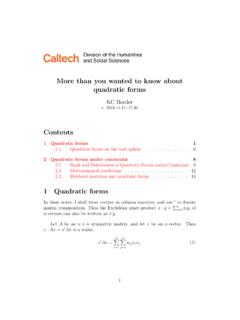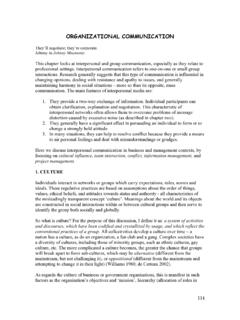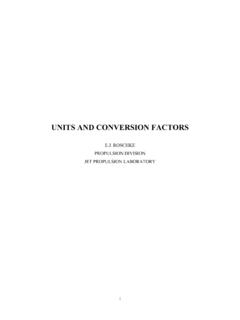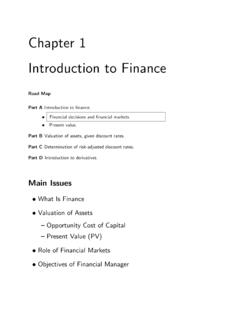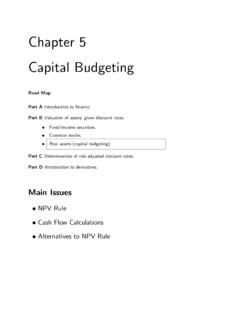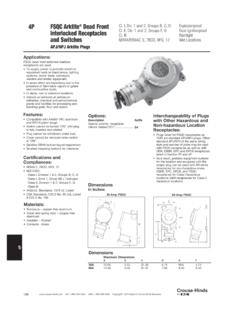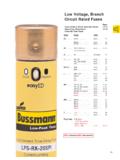Transcription of UNITS AND CONVERSION FACTORS - California Institute of ...
1 UNITS AND CONVERSION FACTORS . ROSCHKE. PROPULSION DIVISION. JET PROPULSION LABORATORY. 1. NOTE: Many years ago I was given a copy of this document, prepared in handwriting, some time in the early 1960's. I did not know the author, Roschke. I have found it to be such a useful reference that I decided to have an electronic version prepared. Recently, I spoke with Dr. Roschke, now retired from the Jet Propulsion Laboratory to learn of the document's origin. In the early 1960's a group of research engineers, largely having backgrounds in mechanical engineering, were engaged in the new field of electric propulsion. They experienced practical annoyances with the mingling of UNITS from mechanical engineering, electrical engineering and physics. That situation motivated Dr. Roschke to assemble this material. Although I have carefully checked the values given here, it is quite possible that some typographical errors remain. I will appreciate learning any corrections that should be made.
2 Culick Mechanical Engineering California Institute of Technology October 2001. 2. UNITS AND CONVERSION FACTORS . Table of Contents Section Page References 3. I. Decimal Multiples and Submultiples 4. II. Description of UNITS Mechanical, Electric, Magnetic 4. III. Equivalent UNITS mksq System 5. IV. Dimensions of esu and emu Electric and Magnetic Quantities 5. V. Dimensions and UNITS for Physical Quantities mksq System 6,7. A. Mechanical 6. B. Thermal 7. C. Electric and Magnetic 7. VI. CONVERSION of mksq UNITS to Gaussian UNITS 8. VII. CONVERSION FACTORS 8-23. A. Plane Angle 8. B. Solid Angle 8. C. Length 9. D. Area 9. E. Volume 9. F. Mass 10. G. Density 10. H. Time 11. I. Speed 11. J. Force 11. K. Pressure 12. L. Energy, Work, Heat 13. M. Specific Energy 14. N. Specific Energy Per unit Temp. 15. O. Power 16. P. Heat Flux 17. Q. Heat Transfer Coefficient 17. R. Thermal Conductivity 18. S. Absolute Viscosity 19. T. Kinematic Viscosity 19.
3 AA. Electric Charge 20. BB. Electric Current 20. CC. Electric Potential 20. DD. Electric Resistance 21. EE. Electric Resistivity 21. FF. Capacitance 21. GG. Inductance 22. 1. Table of Contents continued Section Page HH. Magnetix Flux 22. I I. Magnetomotive Force 22. J J. Magnetic Field Strength, B 23. KK. Magnetic Vector, H 23. VIII. Electromagnetic Constants of Free Space 24. IX. Electromagnetic Constants of Materials 24. X. Some Important Dimensional Constants 25. XI. Some Important Dimensionless Groups 26. XII. The Perfect Gas Law 27,28. A. Nomenclature, Definitions and Equations 27. B. Values of Universal Gas Constant, Boltzmann's Constant and Avogadro's Number in Different UNITS 28. 2. References used in compiling these charts and tables are listed below in the order of most usage . 1. Halliday, D. & Resnick, R., Physics For Students of Science and Engineering, John Wiley, New York, 1960. 2. Forsythe, , Smithsonian Physical Tables, 9th Revised Edition, Publ.
4 4169, Smithsonian Institution, Washington, , 1954. 3. Scott, , Cryogenic Engineering, D. Van Nostrand Inc., Princeton, New Jersey, 1959. 4. Hall, , Thermodynamics of Fluid Flow, Second Printing with revisions, Prentice-Hall Inc., Englewood Cliffs, New Jersey, 1956. 5. Gray, (coordinating editor), American Institute of Physics Handbook, McGraw Hill Inc., New York, 1957. Additional Note on Use of CONVERSION Tables, Part VII. Multiply UNITS appearing in left-hand column by appropriate numerical factor to obtain UNITS appearing in upper row. 3. I. DECIMAL MULTIPLES AND SUB-MULTIPLES. Name Symbol Equivalent Name Symbol Equivalent tera T 1012 deci d 10-1. giga G 109 centi c 10-2. mega M 106 milli m 10-3. kilo k 103 micro 10-6. hecto h 102 nano n 10-9. deca 10 pico p 10-12. II. DESCRIPTION OF UNITS . MECHANICAL UNITS . Quantity cgs mks Length centimeter meter Mass gram kilogram Time second second Force dyne newton Work, Energy erg joule Power watt Dynamic Viscosity poise.
5 Kinematic Viscosity stoke . ELECTRIC AND MAGNETIC UNITS . The esu and emu unit systems are cgs systems. esu denotes electrostatic unit , sometimes given prefix stat , statcoulomb emu denotes electromagnetic unit , sometimes given prefix ab , abcoulomb Some emu UNITS have special names: Quantity emu mksq line Magnetic Flux, weber maxwell Magnetic Field Strength, B gauss weber/m2. Magnetomotive Force, F gilbert amp-turn Magnetic Vector, H oersted amp-turn/m. 4. mksq DIMENSIONS. Length L. Mass M. Time T. Current Q/T. Charge Q. III. EQUIVALENT UNITS mksq SYSTEM. 1 newton = 1 kilogram-meter/(second)2. 1 volt = 1 newton-meter/coulomb 1 amp = 1 coulomb/second 1 joule = 1 newton-meter = 1 coulomb-volt 1 weber = 1 volt-second 1 farad = 1 coulomb/volt 1 henry = 1 weber/amp 1 ohm = 1 volt/amp 1 watt = 1 joule/sec IV. DIMENSIONS OF esu AND emu ELECTRIC AND MAGNETIC QUANTITIES. The fundamental dimensions in both systems are M, L, T.
6 Cgs UNITS used. esu emu emu . Quantity Symbol MxLyTz MxLyTz x y z x y z esu Charge q 3. 2. -1 0 c 3. Field Intensity E - -1 . 2 0 1/c Elec. Displacement D - -1 -2 c Charge Density 0 c 5.. 3. 2 -1 2. Current Density j - -2 . 3. 2 -1 c Elec. Potential V -1 3. 2 -2 1/c Total Current I 3. 2 -2 -1 c Mag. Field Strength B . 3. 0 - -1 1/c 2. Mag. Vector H -2 - -1 c Permittivity 0 0 0 0 -2 2 c2. Permeability 0 -2 2 0 0 0 1/c2. Conductivity 0 0 -1 0 -2 1 c2. Capacitance C 0 1 0 0 -1 2 c2. Inductance L 0 -1 2 0 1 0 1/c2. Resistance R 0 -1 1 0 1 -1 1/c2. *c = velocity of light (free space) in cm/sec 3 1010. Thus: 1 emu of charge = 1010 esu of charge or 1 abcoulomb = 1010 statcoulomb 5. V. DIMENSIONS AND UNITS FOR PHYSICAL QUANTITIES. mksq SYSTEM. A. MECHANICAL QUANTITIES. Quantity Dimensions Derived UNITS Acceleration LT-2 meter/sec2. Angle 0 radian Angular Accleration T-2 radian/sec2. Angular Momentum ML2T-1 kgm-meter2/sec Angular Velocity T-1 radian/sec Area L2 meter2.
7 Energy ML2T-2 joule Force MLT-2 newton Frequency T-1 cycle/sec Gravitational Field Strength LT-2 newton/kgm Length L meter Mass M kilogram Mass Density ML-3 kgm/meter2. Momentum MLT-1 kgm-meter/sec Power ML2T-3 watt Pressure ML-1T-2 newton/meter2. Time T second Torque ML2T-2 newton/meter Velocity LT-1 meter/sec Viscosity (Dynamic) ML-1T-1 kgm/meter-sec Viscosity (Kinematic) L2T-1 meter2/sec Volume L3 meter3. Wave Length L meter Work ML2T-2 joule 6. B. THERMAL QUANTITIES*. Quantity Dimensions Derived UNITS Enthalpy ML2T-2 joule Entropy ML2T-2 -1 joule/K . Gas Constant L2T-2 -1 joule/kgm- K . Internal Energy ML2T-2 joule Specific Heat L2T-2 -1 joule/kgm-K . Temperature K . Thermal Conductivity MLT-3 -1 watt/meter- K . Thermal Diffusivity L2T-1 meter2/sec Heat Transfer Coefficient MT-3 -1 watt/meter2- K . *The dimension of temperature is ; the unit is K . C. ELECTRIC AND MAGNETIC QUANTITIES. Quantity Symbol Dimensions Derived UNITS Charge q Q coulomb Field Intensity E MLT-2Q-1 volt/meter Elec.
8 Displacement D L-2Q coulomb/meter2. Charge Density L-3Q coulomb/meter2. Current Density j L-2T-1Q amp/meter2. Elec. Potential V ML2T-2Q-1 volt Total Current I T-1Q coulomb/sec Mag. Field Strength B MT-1Q-1 weber/meter2. Mag. Vector H L-1T-1Q amp(turn)/meter Permittivity M-1L-3T2Q2 farad/meter Permeability MLQ-2 henry/meter Conductivity M-1L-3TQ2 1/ohm-meter Capacitance C M-1L-2T2Q2 farad Inductance L ML2Q-2 henry Resistance R ML2T-1Q-2 ohm 7. VI. CONVERSION OF mksq UNITS TO GAUSSIAN UNITS . Quantity mksq unit CONVERSION Factor Gaussian unit *. q coulomb = 10-1 c statcoulomb (esu). E volt/meter = 106/c statvolt/cm (esu). D coulomb/meter2 = 4 10-5 c lines/cm2 (esu). coulomb/meter3 = 10-7 c statcoulomb/cm3 (esu). j amp/meter2 = 10-5 abamp/cm2 (emu). V volt = 108/c statvolt (esu). I coulomb/sec : = amp = 10-1 abamp (emu). B weber/meter2 = 104 gauss (emu). H amp-turn/meter = 4 10-3 oersted (emu). farad/meter = 4 10-11c2 (esu).
9 Henry/meter = 107/4 (emu). 1/ohm-meter = 10-11 1/abohm-cm (emu). C farad = 10-9c2 statfarad (esu). L henry = 109 abhenry (emu). R ohm = 109 abohm (emu). *c = vel. of light (free space) in cm/sec 3 1010. Use of table: 1 coulomb = 10-1 (3 1010) statcoulomb = 3 109 statcoulomb VII. CONVERSION FACTORS . NOTE: mksq UNITS ARE CAPITALIZED. USE OF TABLES: EXAMPLE. 1 degree = 10-3 revolutions so, = 10-3 revolutions A. PLANE ANGLE. o RADIAN rev 1 degree = 1 60 3600 10-2 10-3. 1 minute = 10-2 1 60 10-4 10-5. 1 second = 10-4 10-2 1 10-4 10-7. 1 RADIAN = 3438 105 1 1 revolution = 360 104 105 1. 1 revolution = 2 RADIANS = 360o , 1o = 60 = 3600 . B. SOLID ANGLE. 1 sphere = 4 steradians = steradians 8. C. LENGTH. cm METER km in ft mile 1 centimeter = 1 10-2 10-5 10-2 10-6. 1 METER = 100 1 10-3 10-4. 1 kilometer = 105 1000 1 10-4 3281 1 inch = 10-2 10-3 1 10-2 10-5. 1 foot = 10-4 12 1 10-4. 1 statute mile = 105 1609 104 5280 1. 1 foot = 1200/3937 meter 1 light-year = 1012 km 1 meter = 3937/1200 ft 1 par-sec = 1013 km -10.
10 1 angstrom ( ) = 10 meter 1 fathom = 6 ft 1 X- unit = 10-13 meter 1 yard = 3 ft 1 micron = 10-6 meter 1 rod = ft 1 millimicron (mu) = 10-9 meter 1 mil = 10-3 in 1 nautical mile = 1852 meters = statute miles 1 nautical mile = ft D. AREA. METER2 cm2 ft2 in2 circ mil 1 SQUARE METER = 1 104 1550 109. -4 -3. 1 square cm = 10 1 10 105. 1 square foot = 10-2 1 144 108. 1 square inch = 10 -4 -3 1. 10 106. 1 circular mil = 10-10 10-6 10-3 10-7 1. 1 square mile = 27,878,400 ft2 = 640 acres 1 acre = 43,560 ft2 1 barn = 10-28 meter2. 1 hectare = acres E. VOLUME. METER3 cm3 liter ft3 in3. 1 CUBIC METER = 1 106 1000 104. -6. 1 cubic cm = 10 1 10 10-8. -3. 10-2. 1 liter = 10-3 1000 1 10-2 4. 1 cubic foot = 10 10. -2. 1 1728. 1 cubic inch = 10-5 10-2 10-4 1. 1 fluid gallon = 4 fluid quarts = 8 fluid pints =128 fluid ounces = 231 in3. 1 British imperial gallon = in3 (volume of 10 lb H2O at 62o F). 1 liter = cm3 (volume of 1 kgm H2O at its maximum density).
